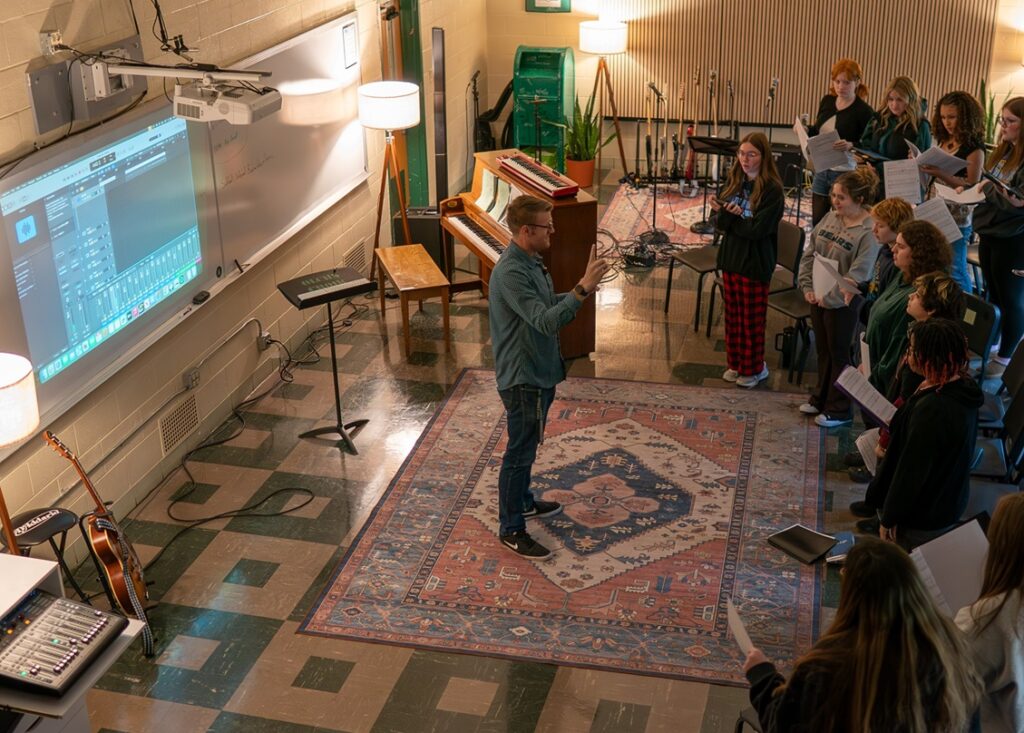Tagged Under:
Give Up Control
When given the opportunity, students reach farther and achieve more, so let them take charge and see what unfolds.
A list of possibilities was listed on the whiteboard. An array of pieces ranging from “conservative” to “otherworldly” for the directors to consider as possible challenges for the high school wind ensemble this year. We’re looking 10 months into the future trying to predict the strengths, areas for growth, and what would create the most incredible musical experience for students who have dedicated so much to be part of this ensemble.
Like most music educators I know, my job is on my mind all the time. The successes, the challenges, the “what ifs” — they’re always swirling around in our brains. The main difference from our profession and that of others is that our decisions will impact the experiences, faces and lives of young people on a daily basis.
So, with that in mind, I took one last look at the whiteboard in my office and walked out in front of my students to discuss the upcoming year. I don’t know what word best describes it best — faith or, perhaps more accurately, trust? — but when given the opportunity, students continually reach farther and achieve more than I imagine. Could it be that I have been the ceiling for their achievement? Are the limitations I placed on them hindering what they can truly accomplish?

A New Path
Why do we create boundaries for our students? We naturally do this with the best intentions in mind. As a parent who sets out rules and expectations for my own children to protect them and keep them safe, I do the same for my students. This is not a bad thing, but it’s something that we must be aware of at all times. The decisions we make send messages to students, and therefore, they must be well thought out and deliberately planned to maximize students’ educational experience.
So, on my daily, continuing journey in this life of education, I decided last year to give away the reins to those who should be in charge. We sat down as an ensemble, laughed, joked and talked about expectations, and then I asked them what they wanted to achieve. It was illuminating to hear what they really wanted from the experience — words like fun, family, ownership, dedication and loud (there were trombone players present) kept coming up.
After establishing what they wanted, we talked about the options and the commitment required for each. This commitment took the form of a massive spreadsheet that outlined the timeline for each student that delineated which measures needed to be learned at accompanying tempos by week. The expectation for what had to be ready for each sectional was laid out for the first eight weeks of the learning period.
I rolled this out more as a question: “Is this what you really want?” They overwhelmingly approved. They were excited to be able to see what was on the horizon and to have the autonomy to shape this experience around their already busy lives. My students are involved in just about every club and organization at Forney High School, nearly all are taking advanced classes, and many of them work in the evenings. The last thing these hard-working students want is for me to drop unexpected work on them because I have no idea when their big tests are, when the busy season in their jobs might be, or when major family events are occurring. Giving them the “control” not only empowers them, but it shows a new level of trust and collaboration between each member and the directors.

What Does it Cost You
Preparation, plain and simple. Coming with a well-thought-out educational and pedagogical plan is essential. As we all know, students can see through when you “wing it,” and the message they receive when there is a lack of preparation is a lack of respect.
The key to success is building trust with students that allows them to communicate if they did not meet the goal set out in the agreed-upon plan. This also promotes honesty about their reality, which they can relay in a conversation with you. Sometimes their work or school life became overwhelming, big projects were due, unforeseen family circumstances, or even procrastination. Addressing these situations with grace and honesty is essential. Together, you can focus on recovering from whatever has happened by creating an actionable plan to get back on track today. This is a learning experience for them, and the important lessons from this — modify and adjust (on top of being honest and accountable) — will serve them throughout their lives.
Micromanagers beware. If you’re anything like me, this will feel like you’re giving away the control you perceived you had and putting it in the hands of teenagers. Well, that’s exactly what you’re doing.
Remember the whole “ceiling” talk above? This is where the rubber meets the road. It has been a major point of growth in my own teaching to see this project develop and see a new and improved form of educational leadership.

Give It Away
As often as possible, acknowledge the work and preparation of those who are staying on course. They are the ones tasked with executing the plan so when they do, let them know that their efforts are noted and appreciated. Remind them of the first conversations and the goals they set for themselves. Look at the students with this mindset: Own anything that doesn’t go well as “your fault or miscalculation” and for anything that does go well, give them 100% of the credit.
One of my favorite TED Talks is Israeli conductor Itay Talgum, who discusses how you can lead like the great conductors. Talgum deeply impacted my leadership style with students, and I took to heart his final message in his presentation: “If you love something, give it away,” which was his take on the famous Richard Bach quote.















